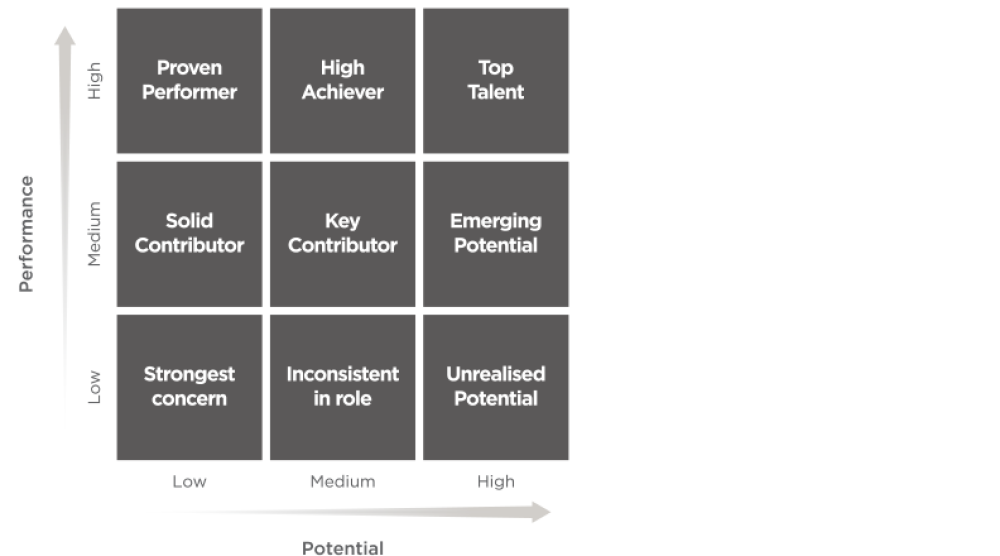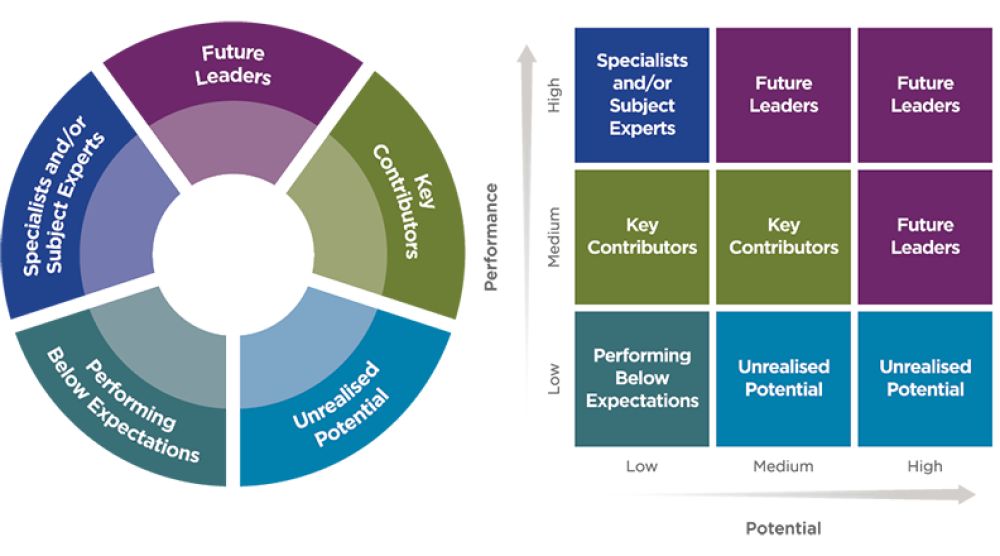Talent segmentation helps organisations prioritise and target their people development and career management approaches. Common definitions for talent segments will support consistency across the sector in identification of talent for cross-sector mobility opportunities and leadership development opportunities.
The Talent Review Framework defines five talent segments for organisations to use in talent reviews. The approach provides organisations with an opportunity to map their talent assessments to these segments. Organisations will determine their own methods for ensuring transparency, consistency and fairness.
There are a range of other talent segmentation tools available, including the commonly used nine-box grid. Organisations can apply any segmentation approach that best meets their needs.
Figure 3. Indicative common nine-box grid

- Low performance and low potential: Strong concern
- Low performance and medium potential: Inconsistent in a role
- Low performance and high potential: Unrealised Potential
- Medium performance and low potential: Solid Contributor
- Medium performance and medium potential: Key Contributor
- Medium performance and high potential: Emerging Potential
- High performance and low potential: Proven Performer
- High performance and medium potential: High Achiever
- High performance and high potential: Top Talent
Regardless of the tool selected, all talent reviews and talent segmentation requires assessments of potential and performance.
What is potential?
Potential is an individual’s capacity to move into roles of greater complexity and scale, demonstrated through a combination of ability, openness and engagement.1
The assessment of an individual’s potential is a point in time assessment, it is not a destination. Individuals and leaders develop and change throughout their career. This means that an individual’s potential may change over time.
Components of potential include:
- Ability: Cognitive capacity; emotional intelligence; learns and adapts quickly; leadership ability.
- Openness: Motivation; openness to career progression; openness to leadership roles.
- Engagement: Values driven; commitment.
1 Ability, Aspiration and Engagement based on Corporate Leadership Council, High Potential Employee Management Survey, 2005.
What is performance?
Performance is an individual’s demonstrated capability and level of achievement against responsibilities and objectives.
Performance assessment considers trends over the past six months or longer term, not only observations over the most recent months (dependent on an individual’s tenure in their current role). The assessment of an individual’s performance for a talent review is a point in time assessment, within the scope of the individual’s current role.
A mapping of the nine-box grid to this five-frame approach is in Figure 4 below for illustrative purposes. Further explanation on the characteristics and development focus of each of the five segments is in the tables below.
Figure 4. Mapping of five-frame approach to nine-box grid

- Future Leaders
- Key Contributors
- Unrealised Potential
- Performing Below Expectations
- Specialists and/or Subject Experts
- Low performance and low potential: Performing Below Expectations
- Low performance and medium potential: Unrealised Potential
- Low performance and high potential: Unrealised Potential
- Medium performance and low potential: Key Contributors
- Medium performance and medium potential: Key Contributor
- Medium performance and high potential: Future Leaders
- High performance and low potential: Specialists and/or Subject Experts
- High performance and medium potential: Future Leaders
- High performance and high potential: Future Leaders
Future leaders
Element | Attributes |
Performance | Exceptional performer on variety of complex assignments and settings |
Potential | Potential to take on an expanded role with greater scope and/or responsibility |
Interest | Interested in pursuing larger or more complex roles at levels above |
Readiness | Assess readiness for increased role complexity or challenge depending on level of potential |
Element | Suggested outcomes |
Focus in the role | Take on stretch leadership assignments where available, exposure through executive sponsorship |
Focus in development | Continue to build leadership capability in increasingly complex roles |
Mobility | Consider increased role complexity through upwards move, or lateral move to gain critical experiences |
Additional development opportunities | Consider this segment when selecting nominees for the NSW Public Sector Leadership Academy. The Leadership Academy definition of a high-potential leader should be applied to identify the most suitable candidates within this cohort (see Section 7 for more detail). |
Specialists and/or subject experts
Element | Attributes |
Performance | Strong performer, usually with high levels of valuable technical expertise |
Potential | May be reaching limit of leadership or other ability or express limited aspiration for change in role |
Interest | Interested in developing additional expert capabilities and pursuing career progression within specialty |
Readiness | Consider readiness for cross-sector opportunities, progression in breadth of role or retention in current role |
Element | Suggested outcomes |
Focus in the role | Should be provided opportunities to continue to develop and use technical skills, coach others, develop mastery |
Focus in development | Consolidate and continue to develop expertise and skills |
Mobility | Consider lateral move across sector or progress to higher level expert role |
Key contributors
Element | Attributes |
Performance | Consistently meets performance expectations, occasionally exceeding expectations |
Potential | Potential to take on some additional responsibilities at the same level |
Interest | Open to pursue moderate levels of career progression |
Readiness | Consider readiness for stretch assignments or lateral mobility |
Element | Suggested outcomes |
Focus in the role | Expose to new experiences and coaching and allow time to demonstrate potential for lateral move |
Focus in development | Improve performance and develop strategic and leadership capabilities through stretch assignments |
Mobility | Consider lateral move across sector |
Unrealised potential
Element | Attributes |
Performance | Inconsistent performance in the role. Could be due to being in a new role, the wrong role, a poorly defined role, or the result of changed expectations or skill gaps |
Potential | Potential to perform in the role and take on an expanded role or additional responsibilities after performance development |
Interest | Open to pursue some level of career progression |
Readiness | Consider readiness for mobility to a more suitable role depending on level of potential |
Element | Suggested outcomes |
Focus in the role | Improve performance through coaching or mentoring |
Focus in development | Improve performance to enable realisation of leadership potential |
Mobility | Consider lateral move to a more suitable role |
Performing below expectations
Element | Attributes |
Performance | Consistently does not meet performance expectations |
Potential | Limited potential to perform in the role |
Interest | Limited openness to leadership or career progression |
Readiness | Assess readiness or need for reallocation to a more suitable role |
Element | Suggested outcomes |
Focus in the role | Coaching or mentoring to significantly improve performance |
Focus in development | Improve performance |
Mobility | Consider lateral or downwards move to reallocate to a more suitable role |